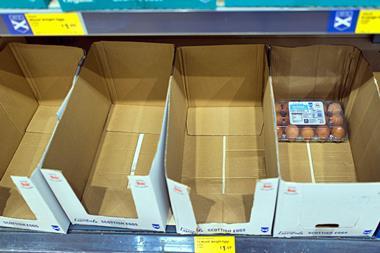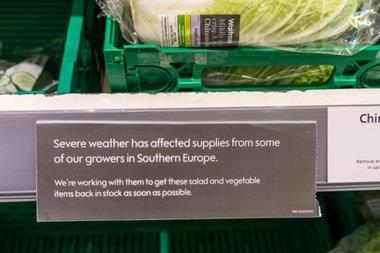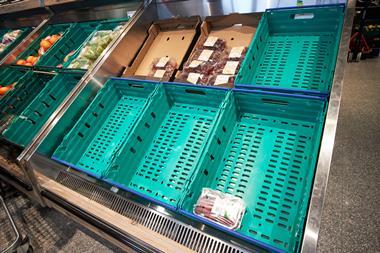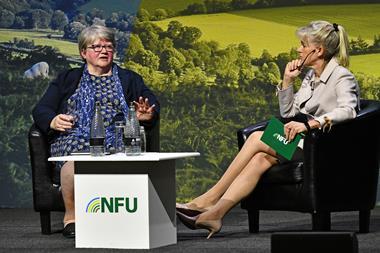Crippling input costs are threatening the future of growers, warned the NFU in November, with sky-high increases in the cost of production leading many to “walk away” from retail contracts or even cut production
Of all the financial pressures to hit over the past year, energy costs sit at the top of the list. Prices rose by an average of 165% in 2022 – representing the biggest hit of any input cost to bottom lines – according to growers polled by Promar International for the NFU.
But the true price of energy for many food and drink businesses could be even higher. Some individual suppliers warn they are facing up to a 300% increase in their annual energy costs due to the impact of the war in Ukraine on wholesale prices. And scale is seemingly no barrier to a hefty bill either – Waitrose told The Grocer it had seen spend on energy climb by 38% year on year last September, while Ocado has seen a £25m rise in its annual bill.
These types of warnings led to the unveiling of a government Energy Bill Relief Scheme for businesses last autumn, which caps bills at less than than half of anticipated winter levels. But in the wake of a deteriorating economic picture following the collapse of Liz Truss’s premiership in October, the government announced a new, watered-down support scheme in January that would replace the EBRS price cap.
A two-tier replacement energy support package is due to come into force on 1 April. But it has already come under fire for ignoring the difficulties faced by many energy-intensive businesses in food and drink and offering fewer businesses a lower level of support.
So, how will it work, who is eligible and who will be short-changed?
What does the new scheme offer?
The government’s new Energy Bills Discount Scheme for UK businesses, charities and the public sector will kick in from 1 April. The scheme will mean all eligible UK businesses will receive a discount on high energy bills until March 2024.
“From 1 April 2023 to 31 March 2024, eligible non-domestic customers who have a contract with a licensed energy supplier will see a unit discount of up to £6.97/MWh automatically applied to their gas bill and a unit discount of up to £19.61/MWh applied to their electricity bill, except for those benefiting from lower energy prices,” explained the government when it was launched in January.
But the scheme offers affected businesses far less support than its predecessor and is also more volatile, due to it being linked to wholesale prices and the fact it is a discount structure – rather than the previous price cap, which restricted the amount customers had to pay to 21.1p per kWh for electricity and 7.5p per kWh for gas.
As a result, critics have suggested the new scheme allows for less planning, as while under the scheme released in 2022 businesses could rely on never paying more than the cap, they are now at the mercy of the wholesale energy market, which can both rise and fall.

Cost-wise, this is manageable for businesses right now. According to the latest figures from the Department for Business, Energy & Industrial Strategy published in December, non-domestic energy was priced at 21.56p per kWh for electricity and 6.53p per kWh for gas. But there is nothing to guarantee it won’t go up in the future, and the discount may not be enough to stop businesses facing crippling price hikes.
The government has also launched an additional support scheme for Energy & Trade Intensive Industries (ETII).
Eligible businesses, in sectors decided by the government, will receive an additional discount on gas and electricity on 70% of energy volumes once the wholesale price has gone over £99/MWh for gas and £185/MWh for electricity. It is also subject to a ‘maximum discount’ of £40.0/MWh for gas and £89.1/MWh for electricity.
Which industries are included, and which ones are not?
The real bone of contention has come from the government’s definition of an energy-intensive industry, something that’s been described as a “car crash” by Ali Capper, executive chair of British Apples & Pears, and something that has raised “red flags” in the poultry industry, according to Richard Griffiths, CEO of the British Poultry Council.
Much of the food industry has been included in the list but there are notable production exemptions: poultry farming and protected horticulture and fruit & vegetable production.
Retailers are also not included in the list, which the British Retail Consortium says will add “significant cost pressures at a time when retailers continue to face strong headwinds”.
Given the recent financial difficulties faced by growers, Capper says she is “staggered” at the omission of fruit & veg, adding it “is hard looking down the vulnerable list to understand how we have been missed out”.
This looks like an understandable objection, given how the government’s extensive list covers more than 100 sectors, including “museum activities” and “library and archive activities”.
As NFU president Minette Batters said when the scheme was announced: ”The omission of horticulture is particularly frustrating. What is the justification for botanical gardens to be included in the scheme, but not food grown in glasshouses?”
Meanwhile, for Griffiths, the neglect of the farming side of the poultry sector is likely to pose big challenges for producers, despite the inclusion of poultry preserving and processing, he suggests, given how this sector is also struggling financially.
“One, the fact that it’s an integrated chain so you have really got to support all of it to keep it going and second is around livestock, where energy is used for the purposes of health and welfare,” says Griffiths, in areas such as the heating of barns.
“While it may not be as intensively used as in slaughtering and processing, it is still an important part of the chain,” he adds.
Similar discrepancies have been seen in fruit & veg. Capper explains that, by her understanding, brewers and cidermakers would be eligible for the scheme when making cider from apples. However, the storage of the apples – also energy intensive – would not be included.
Why have some sectors been omitted?
The government department formerly known as BEIS (which recently became the Department for Energy Security & Net Zero), told The Grocer it had taken a “consistent approach to identifying the most energy and trade-intensive sectors”.
“These thresholds have been set at sectors falling above the 80th percentile for energy intensity, and 60th percentile for trade intensity, plus any sectors eligible for the existing energy compensation and exemption schemes,” a BEIS spokeswoman said.
However, Martin Emmett, chair of the NFU’s Horticulture & Potatoes Board, says this position seemed to be based on “dogma” using standard industry codes rather than considering the more granular elements of industries such as the differences between producing wheat, which is relatively low energy, and tomatoes, which is relatively high due to the need to heat greenhouses.
“Because we have got codes covering all of edible horticulture, the net figure for the whole industry suggests we are not a high energy user, but within that we have got whole sectors which are high energy users,” he says, pointing to the needs of tomato, cucumber, pepper and herb businesses and those which store produce for a long time, such as apples and potatoes.
It doesn’t seem like the government has “a decent methodology,” Griffiths says. “They certainly haven’t come to us and asked us what do you do? Why should support be given?”
“I would like to think it was an oversight that our sector has been excluded but I am not sure anyone has an answer to that yet,” says Capper.
So what will this mean for food production?
Businesses will continue to be subject to considerable energy cost volatility, which will have an impact on the bottom line and business confidence.
Capper says that it is “very significant” that this volatility has been reintroduced and is changing how growers plan for the next season, with many reducing the number of new trees being planted.
“Where growers have a choice with an annual crop they are simply planning to grow less and where growers have less of a choice, as with a perennial crop, they are just not renewing as they would normally,” she explains.
“I am sure we will see underutilised infrastructure, such as glass houses and soft fruit polytunnels,” she warns.
The scaling back of production is also a concern in the poultry sector, particularly for smaller companies, and Griffiths suggests that by next Christmas there may be less choice of poultry on shelf as more and more producers cut back.

And this is not just limited to fresh foods, with frozen also seeing an increase in costs and an inability to continue production at the same rate.
“Some of our member businesses which are not eligible for the scheme have had to look at cutting certain lines or reducing the number of trading days to cope with rising costs,” says Rupert Ashby, CEO of the British Frozen Food Federation.
For Griffiths, the main problem with this situation is that it will “feed into greater food inflation”.
His comments are echoed by Ashby, who says that “whilst our members have tried to withhold passing on the ever-increasing costs to customers, many have now reached the point where this can no longer be avoided, which has partly driven the food inflation we have seen recently”.
“Although the government has little control over the international factors driving inflation, the food industry surely must be top of the list for continued assistance where that is possible,” he adds.
It is the latest in a long list of rising costs across the food industry and that ultimately means without more support, those costs will have to be passed on to the consumer.
What happens next?
Wholesale energy costs have started to come down, meaning that some of the scheme will not even be applicable as we have now fallen below the threshold required to have payment.
However, the volatility of the market remains a concern and sectors left out of the additional support are feeling “gloomy” and “depressed”, says Capper, with purse-strings becoming increasingly tight.
This is just the tip of the iceberg for Griffiths, who explains, “It’s energy on top of bird flu on top of labour on top of feed price on top of Covid on top of everything else on top of the effects of Brexit, which are still not fixed. So energy is massively important, a big concern but it’s also part of an even bigger concern.”
He says that the concern now for the poultry meat sector is that “we are going to be in a similar position to eggs,” tight on supply and seeing limited returns.
In horticulture, growers have already walked away, according to Emmett. There is now a “reduced area of, for example tomato production, and within that a reduced season, to minimise the impacts of the energy cost”.
As a result, the NFU is now looking at how it can prevent further exits from the sector should energy costs rise again. It is about “creating an environment where industry doesn’t have to face that fluctuation and take those types of gambles” which is why the NFU is currently petitioning the government to include horticulture on any future energy support scheme.
Additionally, some hope has been brought by the creation of the Department for Energy Security & Net Zero, announced in Febraury and run by Grant Shapps.
It is an opportunity, according to NFU vice president Tom Bradshaw, for the government to “review the ETII scheme and ensure that food producing businesses which are energy intensive, such as poultry, fruit & vegetables grown in glasshouses and those using refrigerated storage, are supported through the ongoing energy crisis”.




















No comments yet